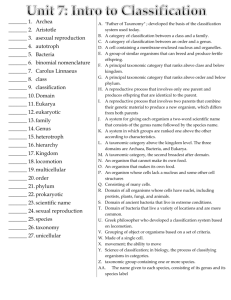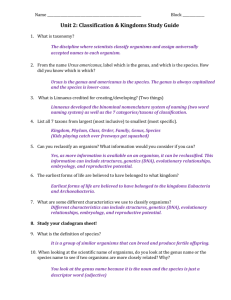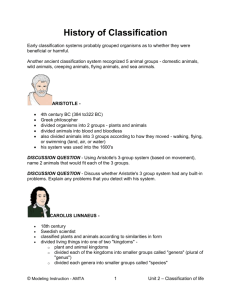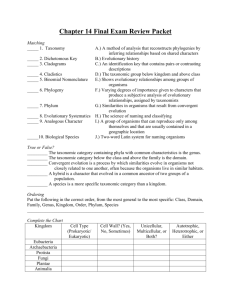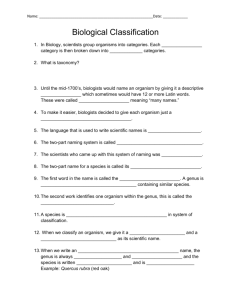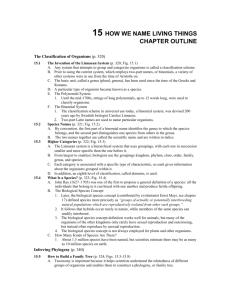Organizing Life's Diversity: Classification & Taxonomy
advertisement
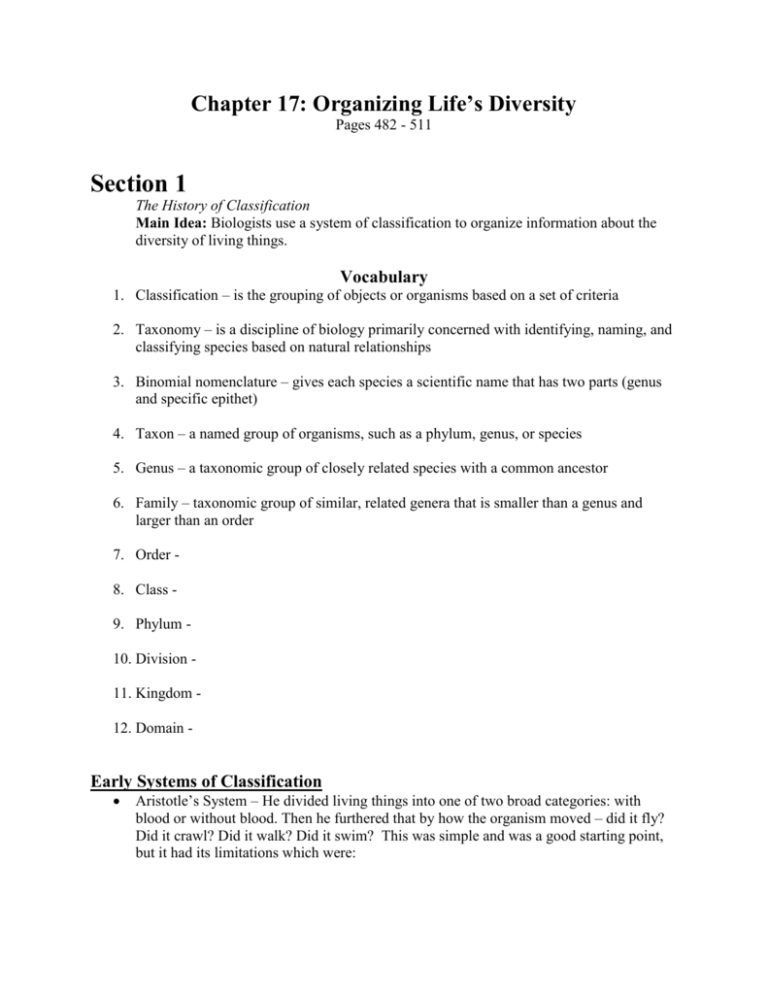
Chapter 17: Organizing Life’s Diversity Pages 482 - 511 Section 1 The History of Classification Main Idea: Biologists use a system of classification to organize information about the diversity of living things. Vocabulary 1. Classification – is the grouping of objects or organisms based on a set of criteria 2. Taxonomy – is a discipline of biology primarily concerned with identifying, naming, and classifying species based on natural relationships 3. Binomial nomenclature – gives each species a scientific name that has two parts (genus and specific epithet) 4. Taxon – a named group of organisms, such as a phylum, genus, or species 5. Genus – a taxonomic group of closely related species with a common ancestor 6. Family – taxonomic group of similar, related genera that is smaller than a genus and larger than an order 7. Order 8. Class 9. Phylum 10. Division 11. Kingdom 12. Domain - Early Systems of Classification Aristotle’s System – He divided living things into one of two broad categories: with blood or without blood. Then he furthered that by how the organism moved – did it fly? Did it crawl? Did it walk? Did it swim? This was simple and was a good starting point, but it had its limitations which were: Linnaeus’ System Binomial Nomenclature – Linnaeus came up with this. It gives each species a scientific name that has two parts. The first part is the genus and the second part is the specific epithet, or scientific name, that identifies the species. Latin is the base of this system because Latin is an unchanging language. We call it a dead language. The red cardinal is used as an example. We may call it a red bird, a cardinal, or flappy bird as a common name that changes depending on what part of the country we are in; however, the scientific name never changes and it can be used as a universal classification by scientists or anyone who bothers to learn the Latin name: Cardinalis cardinalis. Modern Classification Systems Taxonomic Categories Species and Genus Family Higher Taxa Systematics Applications Section 2 Modern Classification Main Idea: Classification systems have changed over time as information has increased. Vocabulary 1. Phylogeny 2. Character - 3. Molecular clock 4. Cladistics – 5. Cladogram – diagram with branches that represents the hypothesized phylogeny or evolution of a species or group; uses bioinformatics, morphological studies, and information from DNA studies. To the left is an example of how it is hypothesized our modern “killer whales” evolved. http://www.popscicoll.org/whaleevolution/cladogram.png 6. Determining Species Typological Species Concept Biological Species Concept Phylogenetic Species Concept Characters Morphological Characters Biochemical Characters Phylogenetic Reconstruction Cladograms The Tree of Life Section 3 Domains and Kingdoms Main Idea: The most widely used biological classification system has six kingdoms within three domains. Vocabulary 1. Eubacteria 2. Archaea 3. Protist –eukaryotic organisms can be unicellular, colonial, or multicellular; they do not have organs. They are not necessarily grouped together because they are similar to each other, but because they are too different from anything else to be grouped into any other group. By default, they are put together. The plant-like protists are called algae (ex. Kelp); they perform photosynthesis. The animal-like protists are called protozoans (ex. amoebas). The fungus-like protists are your slime molds and mildews. Then there is the euglenoids that have both plant-like and animal-like characteristics. 4. Fungus Grouping Species a. The broadest category in the classification system is the domain b. There are three domains: bacteria, archaea, and eukarya. c. Within these three domains are six kingdoms: bacteria, archaea, protists, fungi, plantae, and Animalia. d. Organisms are classified into domains according to cell type and structure; and into kingdoms according to cell type, structure, and nutrition. e. This system has been in use for only about two decades (book published in 2008) f. The reason the system was changed was because scientists discovered an entirely new kind of organism in the 1970’s. These new organisms were unicellular prokaryotes that were named archaebacteria. Since they were nothing like the other known bacteria, they were renamed in 1990 and given their own domain of Archaea. Domain Bacteria Domain Archaea Domain Eukarya Kingdom Protista Kingdom Fungi Kingdom Plantae Kingdom Animalia Viruses – an exception Example of a taxonomic chart for Panthera pardus, aka Leopard https://www.google.com/search?q=classification+chart&safe=active&rlz=1T4MXGB_enUS532US532&source=lnms&tbm=isch&sa= X&ei=pk5iU6KaKsPE8QHxtIC4Bw&sqi=2&ved=0CAYQ_AUoAQ&biw=1280&bih=820#q=taxonomic+chart+domain&safe=activ e&tbm=isch&facrc=_&imgdii=_&imgrc=YGXTbKBsjSSfQM%253A%3BvazUTZi9pj1WYM%3Bhttps%253A%252F%252Ffacinat ingamazinganimals.files.wordpress.com%252F2012%252F03%252Flevels_of_classification.jpg%3Bhttp%253A%252F%252Fwww. ummah.com%252Fforum%252Fshowthread.php%253F357367-Your-guide-to-quot-Evolution-quot-amp-quot-Darwinismquot%3B638%3B700 http://www.scholarsjunction.com/project-images/bio/Taxonomy.gif http://imr.jenniferakkermans.com/wp-content/uploads/2011/05/taxonomy-chart1.jpg


